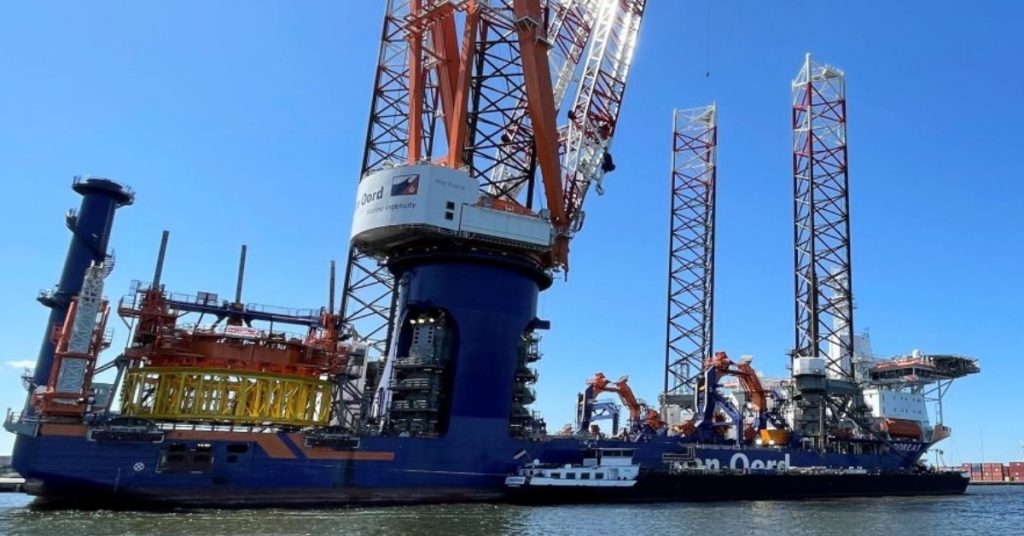The Port of Amsterdam has reached a major milestone in sustainable maritime operations with its first ship-to-ship methanol bunkering. Last week, 500 tonnes of green methanol were successfully transferred to Van Oord’s new offshore installation vessel Boreas at the TMA Logistics terminal in Amerikahaven.
The methanol was delivered by the bunker vessel Chicago, operated by Unibarge, and supplied by OCI HyFuels. This operation marks a pivotal moment in the port’s ongoing efforts to facilitate the transition to cleaner marine fuels.
A Step Forward for Green Shipping
The Boreas, one of the largest offshore installation vessels of its kind, is the first in its class designed to run on methanol. In addition to its green fuel capabilities, the vessel is equipped with a 6,000 kWh battery system and advanced emission control technology, significantly reducing nitrogen oxide (NOₓ) emissions and overall environmental impact.
“This vessel symbolizes the future of offshore operations,” said Jaap de Jong, Project Director at Van Oord. “We’re excited to deploy Boreas in our offshore wind projects and contribute to the energy transition.”
A commemorative plaque was presented to the vessel’s captain to mark this occasion, highlighting the ship’s innovative design and green credentials.
Pioneering the Use of Green Methanol
The methanol bunkered was ISCC-certified and produced from sustainable feedstocks like waste and residual materials, offering a considerable reduction in CO₂, particulate matter, and nitrogen emissions. Henri van der Weide, Clean Shipping Advisor at the Port of Amsterdam, emphasized the importance of this development: “Van Oord’s choice of methanol positions them as a trailblazer in sustainable marine fuel adoption.”
Amsterdam’s Vision as a Multi-Fuel Port
The bunkering aligns with the port’s broader “Clean Shipping Vision,” which aims to establish Amsterdam as a leading multi-fuel port. In support of this goal, the port authority is actively developing safety standards for a range of alternative fuels, including LNG, hydrogen, ammonia, and now methanol.
“We’re working closely with the Clean Marine Fuels Working Group of the International Association of Ports and Harbors (IAPH) to set the groundwork for safe and effective fuel transitions,” said van der Weide. “Together, we’ve developed dedicated safety checklists and protocols to support these complex operations.”
Ensuring Safe Fuel Transfers
Safety remains paramount during alternative fuel bunkering operations. Methanol bunkering in Amsterdam requires a licensed operator compliant with IAPH standards, the use of a validated safety checklist, and thorough port authority assessment of designated bunkering locations. While LNG bunkering has become routine in the port, and hydrogen bunkering has recently been introduced, this event marked the port’s first methanol bunkering between two vessels.
With this milestone, the Port of Amsterdam strengthens its role as a key player in the maritime energy transition, paving the way for increased adoption of sustainable fuels in global shipping.
Tags: Bunkerig, Green Shipping, Maritime, Methanol, Port of Amsterdam, Sustainability



Recent Posts
DNV Grants Approval in Principle for New Ammonia Bunkering Vessel Design
Proteus Launches Modular Hydrogen Fuel Cell System for Maritime Sector
Van Oord Unveils Boreas, World’s Largest and Most Sustainable Offshore Wind Installation Vessel
New methanol-fuelled vessel ‘Berlin Maersk’ to enter service
NMPA wins greentech global environment award
CMA CGM in negotiations with Indian shipyards for LNG-powered shipbuilding
L&T to Develop Green Hydrogen and Ammonia Projects in Kandla
Pan Ocean Orders Two Eco-Ready VLCCs from HD Hyundai Heavy Industries